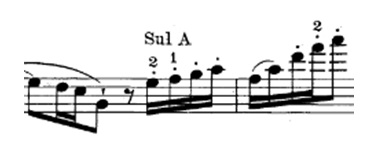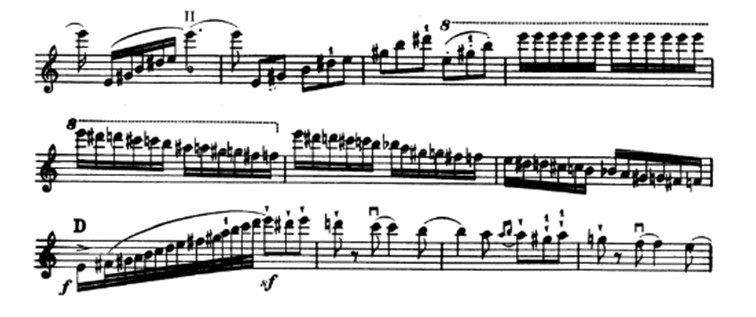Articulation can be discussed as an important component of the sound production. From this point, articulation should be regarded as a range of techniques that are used in order to accentuate the sound of notes with the focus on their length, intensity, beginning, and end (Lawson and Stowell 47). Moreover, while discussing articulation with reference to the violin, much attention should be paid to bowing techniques because they determine the principles of articulation for stringed instruments. Thus, according to Stowell, while playing the violin, performers use bowing techniques in order to influence articulation of the sound because it “gives life to the notes” (132). I should state that the principles of articulation need to be discussed in detail while referring to the history of developing rules for notation and describing examples of bowing techniques. For this purpose, it is important to use examples from Introduction and Rondo Capriccioso in A Minor that was composed by Camille Saint-Saens in 1863.
First, it is significant to note that, before the seventeenth century and during the Baroque era, composers and musicians did not use articulation signs actively. As a result, performers followed the rules for articulation that were typical of the certain period (Lawson and Stowell 47). Still, when composers chose to use certain articulation signs in their notes, there were no agreements regarding the effects that were marked with the help of this or that sign. For instance, according to Lawson and Stowell, while preparing the notes for his works, Couperin “often used a slanting stroke or strokes to indicate those notes to be grouped closely together, while the practice of connecting notes with beams … also provided clues to phrasing and articulation” (47). The situation seemed to change in the eighteenth century, when composers began to use articulation marks more actively, and performers tried to follow them precisely (Galamian and Thomas 89). Still, in some cases, the actual meaning of those marks remained to be ambiguous (Lawson and Stowell 47). From this point, performers were rather independent in their interpretation of the provided marks and signs, and more attention was paid to “the particular idiom and character of the work, as well as the individual taste of the performer” (Lawson and Stowell 48). Therefore, I should focus on specific marks used by composers as articulation sings in works for the violin, where the impact of bowing techniques on producing the sound is significant.
Traditionally, to accentuate changes in the note and certain sound effects in notation, composers used horizontal and vertical strokes, dots, and different slurs. Dots and strokes were often used to indicate short notes, but it is important to state that dots were also used to accentuate the “less abrupt staccato than the stroke or wedge” (Lawson and Stowell 47). Slurs were used to identify legato as a specific type of articulation when notes were played without breaks between them. According to Lawson and Stowell, in the eighteenth century, “true legato bowing with most pre-Tourte bows was achieved only by slurring, due emphasis being given to the first note of a slur” (51). The non-legato character was typical of strokes made with the help of pre-Tourte bows that were used before the 1770s (Kennedy, Rutherford-Johnson, and Kennedy 22).
While using pre-Tourte bows, it was possible to change the intensity of the sound and its softness. Performers were also able to change the speed of strokes (Galamian and Thomas 54). Lawson and Stowell paid attention to the fact that, during that period, detached notes could be associated with “lively Allegros,” and slurred notes were associated with “tender Adagios,” as it was noted by Mattheson, who chose to interpret signs depending on his own vision of articulation (48). However, the clearer explanations of staccato and slurring as presented with the help of articulation marks appeared only in the nineteenth century.
In order to respond to confusion about using articulation marks to emphasize a certain sound effect, Friedrich Starke provided the detailed explanation of signs that could be used to determine staccato in notes. According to Starke, dashes are usually utilized to represent “the short, sharp touch” in which a note can receive only “a quarter of its value”; dots determine “the semi-sharp touch,” and such notes can be played with accentuating only “half their value”; furthermore, there is also portamento that is “marked by dots below or above a slur,” and “each note receives three-quarters of its value” (48). In order to illustrate how these articulation types were reflected in musical works, it is necessary to refer to examples from Introduction and Rondo Capriccioso in A Minor by Saint-Saens.
Thus, staccato is a type of articulation in playing the violin that is emphasized with the help of a dot which is necessary to determine that the note should be played as short and separated from the other note (Kennedy, Rutherford-Johnson, and Kennedy 29). Legato is marked with the help of a slur, and it means playing notes in a smooth manner, without accentuating breaks between them (Auer and Martens 38). Saint-Saens actively used staccato in his work in order to emphasize the use of short detached notes (Appendix A, Example 1). However, while referring to the examples from the piece by Saint-Saens, it is also important to pay attention to the words by Lawson and Stowell.
According to the authors, in contrast to the modern staccato, the staccato stroke that was used in the eighteenth-century “involved a ‘breath’ or articulation between notes somewhat greater than the articulation of the normal separate stroke and it was often conveyed by lifting the bow from the string after each stroke, especially in slow tempos” (Lawson and Stowell 51). As a result, while playing such kind of staccato, performers often achieved the effects associated with the modern spiccato (Lawson and Stowell 51). Thus, in addition to traditional staccato, Saint-Saens used spiccato in his work while accentuating bouncing on the strings (Appendix A, Example 2). Furthermore, Saint-Saens was also known as a master of legato that was also used in the discussed work. I should state that this articulation technique seems to add more elegance to the piece (Appendix A, Example 3). Moreover, in the eighteenth and nineteenth centuries, sforzando became actively used as a technique applied to Tourte bows (Galamian and Thomas 67). Therefore, in his Introduction and Rondo Capriccioso, Saint-Saens allowed using this technique in order to emphasize certain notes in addition to using spiccato and different types of staccato (Saint-Saens 18).
In his famous composition, Saint-Saens also used the slurred up-bow staccato. The composer marked several short notes with the help of a dot, and he also used a slur in order to demonstrate how these notes could be connected while being played by a performer (Appendix A, Example 4). It is important to note that this example demonstrated how the principles of articulation typical of music in the nineteenth century differed from the articulation rules characteristic of the eighteenth century. Thus, according to Lawson and Stowell, in the eighteenth century, theorists referred to “three broad categories of articulation, with staccato and legato … serving as the two extremes and a semi-detached ‘ordinary’ manner of playing in the middleground” (48). From this point, in the eighteenth century, staccatos and slurs became to determine two variants of the accepted articulation. In addition, the focus on bowing techniques and aspects of the touch were also accentuated with reference to legato and marcato (Kennedy, Rutherford-Johnson, and Kennedy 32). However, the emphasis on the slurred staccato became typical of the nineteenth century because composers chose not to refer to extremes in articulation.
Nevertheless, the use of the slurred staccato became a challenge for determining strict principles of providing articulation marks. Thus, “ambiguity of notation” typical of music in the seventeenth and eighteenth centuries caused formulating another set of rules to be used by composers while marking the notes in the nineteenth century (Stowell 77). While following Stowell, it is important to note that dots that were put “above or under the notes in slow movements” indicated “an on-the-string execution rather like a portato” (77). In addition, strokes that were put above or under the certain notes “were more common in faster tempos and generally indicated playing in ‘lifted’ style, brief passages being executed in either up- or down-bow but longer passages normally being taken in the up-bow” (Stowell 77).
I should state one more time that the emphasis on bowing in a discussion of articulation related to the violin was important because playing techniques that were used with different instruments influenced the character and quality of articulation significantly. For instance, some performers chose to play the violin part from Introduction and Rondo Capriccioso while using a flute. As a result, the quality and features of produced sounds differed significantly while using a violin or a flute, and those differences could be noticed in spite of the used articulation. Therefore, following Lawson and Stowell, it is possible to state that, “for bowed stringed instruments, management of the bow provided the main articulation resource” (51). It is also important to refer to differences in bow strokes associated with the use of pre-Tourte and Tourte bows in the context of articulation effects (Auer and Martens 54).
It is possible to conclude that articulation and bowing techniques are connected directly while speaking about specific articulation for the violin. In order to produce a sound that is emphasized in the notes with the help of the certain articulation sign, it is important to apply different bowing techniques. However, the rules regarding the use of articulation signs that are actively utilized today were not stated clearly during a long period of time. As a result, both composers and performers had certain freedom in interpreting articulation marks used in notation. Nevertheless, the principles of articulation that were formulated in the nineteenth century are not only reflected in the notes for such pieces as Introduction and Rondo Capriccioso, but they are also actively used even today.
References
Auer, Leopold, and Frederick Martens. Violin Master Works and Their Interpretation. New York: Courier Corporation, 2013. Print.
Galamian, Ivan, and Sally Thomas. Principles of Violin Playing and Teaching. New York: Courier Corporation, 2013. Print.
Kennedy, Michael, Tim Rutherford-Johnson, and Joyce Kennedy. The Oxford Dictionary of Music. Oxford: Oxford University Press, 2013. Print.
Lawson, Colin, and Robin Stowell. The Historical Performance of Music: An Introduction. Cambridge: Cambridge University Press, 1999. Print.
Saint-Saens, Camille. Havanaise Op. 83 and Introduction and Rondo Capriccioso Op. 28 for Violin and Piano. New York: Courier Corporation, 1999. Print.
Stowell, Robin. The Early Violin and Viola: A Practical Guide. Cambridge: Cambridge University Press, 2011. Print.
Appendix A



